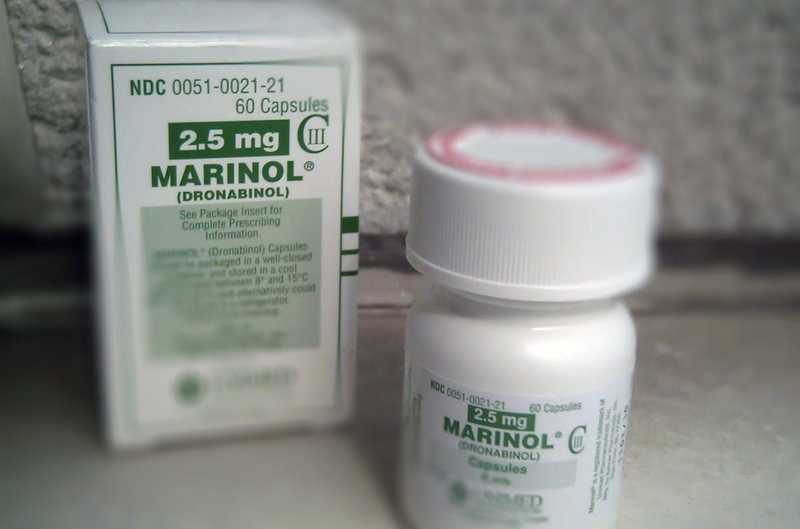Cannabis and Marinol are both possible treatments for the side effects of chemotherapy and the symptoms of AIDS. Each option has its own benefits and drawbacks. However, cannabis may be a more effective treatment for many patients, as it has extra therapeutic properties compared to Marinol.
What is Marinol?
Marinol is a synthetic form of THC, one of the main psychoactive components of cannabis. In May 1985, the FDA approved Marinol as a prescription medication for the treatment of nausea and vomiting caused by chemotherapy. It can also stimulate appetite, which led to the FDA extending the approval to AIDS patients suffering from anorexia and weight loss.
How Does Marinol Differ From Cannabis?
The active ingredient of Marinol is dronabinol, which is a synthetic form of THC. Marijuana contains many active compounds in addition to THC. These include cannabidol (CBD), cannabinol, cannabichromine, cannabigerol, terpenoids, flavonoids, phenols, and various oils. Research has identified 66 naturally occurring chemical compounds in cannabis, many of which are known as cannabinoids.
CBD has many potentially beneficial effects, which are not provided by Marinol. CBD has anticonvulsant, antispasmodic, and anti-inflammatory properties. It also reduces anxiety and tackles psychosis, as well as suppressing the growth of tumors in some situations.
Cannabinol is also an anticonvulsant, while cannabichromine acts as an antidepressant. Both these compounds can reduce inflammation, as can many of the flavonoids, oils, and phenols found in cannabis.
Is Cannabis or Marinol More Effective?
Both cannabis and Marinol bring benefits to some people. However, Marinol has some key downsides compared to marijuana. Firstly, Marinol is more expensive than medical marijuana, which puts it out of reach of many patients. More importantly, Marinol also causes unwanted side effects for many users, while offering only limited benefits compared to the natural plant. The side effects of Marinol include drowsiness, dizziness, nausea, vomiting, clumsiness and trouble thinking clearly.
THC is the main psychoactive component of cannabis. Therefore, users of Marinol, which is a pure synthetic form of THC, often experience a "high" feeling when taking the drug. While feeling high is also a well-known effect of taking cannabis, the other cannabinoids in marijuana temper the effects of the THC, reducing negative psychological side effects such as anxiety. Therefore, the psychological experience is often better for people who take natural marijuana than for those who take synthetic THC.
The other benefit of marijuana is that patients can consume it in a variety of ways, including inhalation, oral ingestion, vaporization, or in a cream or oil. In contrast, Marinol is only currently available in the form of gelatin capsules, which come in dosages of 2.5 mg, 5 mg or 10 mg. Each oral pill can take up to an hour to have an effect, which means that it can be difficult for patients to determine the right dosage. Vaporization of medical marijuana has an immediate effect, helping patients to get quick relief from their symptoms without the risk of taking a dose that is too strong. The fact that the drug doesn't have to be swallowed is also an important benefit for patients who are struggling with nausea or vomiting.
The oral administration of Marinol poses further problems. After passing through the digestive system, Marinol absorbs into the bloodstream and passes to the liver. The liver metabolizes Marinol into a plethora of other chemicals, including 11-hydroxy-THC, which is four or five times as strong as natural THC. This could explain why so many Marinol users report that its psychoactive effects are much greater than those of natural cannabis. The lack of CBD, which reduces anxiety, could also contribute to the problem.
What is Marinol Used For?
The FDA has approved Marinol as a treatment for lack of appetite and weight loss in patients with AIDS. The drug is also approved as a treatment for nausea and vomiting caused by chemotherapy, but only for cancer patients who have not responded to conventional anti-nausea treatments.
There are many situations in which the FDA advises against the use of Marinol. For example, Marinol must be used with caution in patients who have heart disorders, as well as those with depression, mania, schizophrenia or a history of substance abuse. There are also possible interactions with many other drugs, including alcohol and benzodiazepines, which can make Marinol unsuitable for some patients.
Marinol or Marijuana?
There is increasing evidence that marijuana is a more effective treatment than Marinol for a range of conditions, including the side effects of chemotherapy and the symptoms of AIDS. The other compounds in marijuana, such as cannabidol, cannabinol, and terpenoids, offer benefits that extend far beyond those offered by THC, including pain relief and a decrease in anxiety. Cancer and AIDS patients often experience pain, in addition to the nausea and anorexia that THC can treat.
Perhaps the most important argument for using marijuana rather than Marinol is that the natural plant often causes far fewer side effects, particularly psychoactive side effects such as anxiety. FDA approval for medical marijuana could allow sufferers of cancer and AIDS to benefit from the entourage effect of cannabis, where the various compounds in cannabis work together to create an overall beneficial effect.
